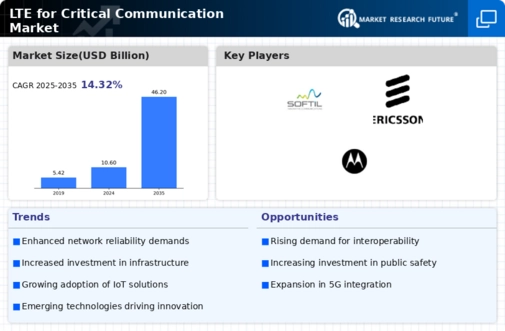Top Industry Leaders in the LTE Critical Communication Market
Competitive Landscape of the LTE for Critical Communication Market
The LTE critical communication market, encompassing sectors like public safety, utilities, energy, and transportation, demands reliable and robust communication infrastructure. As traditional technologies like Land Mobile Radio (LMR) reach their limitations, Long-Term Evolution (LTE) emerges as a promising contender, pushing the boundaries of what's possible. This report delves into the competitive landscape of LTE for critical communication, analyzing key players, their strategies, and market dynamics.
Key Players:
- Sepura Plc. (UK)
- Rohill Technologies B.V. (The Netherlands)
- Samsung Group (South Korea)
- Nokia Corporation (Finland)
- Teltronic S.A. (Spain)
- Softil Ltd. (Israel)
- Qualcomm Technologies Inc. (US)
- Ericcson (Sweden)
- Motorola Inc. (US)
- Telstra Corporation Ltd. (Australia)
Strategies Adopted:
- Product differentiation: Players are constantly innovating, emphasizing features like high availability, low latency, and security in their LTE offerings. Advanced functionalities like mission-critical push-to-talk, priority pre-emption, and location tracking are differentiating factors.
- Strategic partnerships and collaborations: To address diverse needs and expand reach, established players are partnering with specialized vendors and startups. This opens up access to niche expertise and enables quicker innovation cycles.
- Focus on vertical markets: Players are tailoring their solutions and services to specific verticals like public safety, utilities, and transportation. This deepens understanding of user needs and allows for targeted marketing and sales efforts.
- Government contracts and regulatory landscape: Securing government contracts and navigating complex regulatory frameworks are crucial for success in this market. Strong government relationships and proactive adaptation to evolving regulations are key differentiators.
Factors for Market Share Analysis:
- Product portfolio breadth and depth: Players with a comprehensive range of LTE equipment, software, and services hold an advantage.
- Technological leadership: Continuous investment in R&D and deployment of cutting-edge features like network slicing and edge computing attracts customers.
- Global reach and local presence: A strong international presence coupled with localized solutions tailored to regional needs is crucial.
- Customer service and support: Reliable and responsive customer support, especially for mission-critical deployments, builds trust and loyalty.
- Pricing and cost-effectiveness: Balancing competitive pricing with feature-rich offerings in a value-conscious market is essential.
New and Emerging Companies:
- Drone communication startups: Companies like SkyeBrowse and AirMap are developing LTE-based solutions for secure and reliable drone communication, catering to growing demand in surveillance, inspection, and delivery applications.
- Private LTE network providers: Players like Celona and Federated Wireless offer scalable and cost-effective private LTE networks for industrial and enterprise IoT applications, challenging traditional cellular network dependence.
- Edge computing vendors: Companies like Mobiledge and FogHorn Systems are integrating edge computing capabilities into LTE networks, enabling real-time data processing and analysis for mission-critical applications.
Current Company Investment Trends:
- Network modernization: Players are investing heavily in upgrading existing LTE networks with features like mission-critical push-to-talk and network slicing to cater to critical communication needs.
- Cloud-based solutions: The transition towards cloud-based network management and software platforms is gaining traction, offering scalability and cost benefits.
- Open ecosystems and interoperability: Promoting open standards and interoperable solutions is crucial for wider adoption and fostering a healthy competitive landscape.
- Security and privacy: Investments in robust security measures and data privacy protection are paramount for building trust and meeting stringent regulatory requirements.
- Research and development in next-generation technologies: Leading players are actively involved in research on 5G and beyond, aiming to future-proof their offerings and maintain their competitive edge.
Latest Company Updates:
December 14, 2023: FirstNet Rapid Deploy launches a pre-commercial trial of its innovative private LTE network solution, targeting emergency response teams and temporary deployments in disaster zones.
January 4, 2024: The GSMA publishes a report highlighting the rapid growth of LTE for critical communication, emphasizing its potential to transform industries like public safety, transportation, and utilities. The report forecasts a doubling of the market size by 2025.
January 5, 2024: The OpenAirInterface Foundation announces a significant breakthrough in interoperability between different vendors' LTE equipment, promoting open standards and fostering a more competitive market for critical communication solutions.









